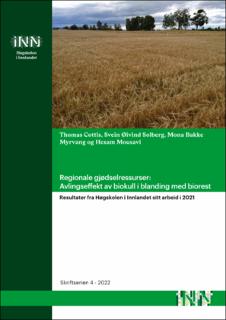Regionale gjødselressurser: avlingseffekt av biokull i blanding med biorest. Resultater fra Høgskolen i Innlandet sitt arbeid i 2021
Research report
Published version
Permanent lenke
https://hdl.handle.net/11250/2977151Utgivelsesdato
2022Metadata
Vis full innførselSamlinger
Sammendrag
På oppdrag for prosjekt «Utvikling av ny regional gjødselvare», gjennomførte Institutt for jordbruksfag ved Høyskolen i Innlandet et feltforsøk, et lagringsforsøk og et potteforsøk for å finne avlingseffekter av kombinasjonen av biokull og biorest. Biokullet har flis av tørrgran som råstoff, og er produsert av Oplandske Bioenergi. Bioresten er produsert av det interkommunale renovasjonsselskapet GLØR på Lillehammer. Feltforsøket ble anlagt, driftet og høstet av NLR Innlandet. Feltforsøket viste at tilførsel av 100 til 800 kg biokull pr dekar uten direkte sammenblanding med 4 tonn biorest pr dekar, ikke påvirket avling i bygg hverken positivt eller negativt. Lagringsforsøket viste at biokull reduserer ammoniakktapet fra biorest. Denne effekten skyldes trolig flytelaget som biokullet kan danne når det er tilstrekkelige mengder i forhold til gjødselbeholderens størrelse. Lagrings‐ og potteforsøket viste at direkte sammenblanding før tilførsel til jord av de samme mengdeforholdene av biokull og biorest som i feltforsøket, ga synkende avling med stigende mengder biokull. Tre måneders lagringstid av disse blandingene ga lavere avling enn kort lagring. 3 måneders lagringstid med finsiktet biokull ga enda lavere avling enn vanlig biokull. Best avling i potteforsøket ga biorest uten innblandet biokull. Forklaringen på dette er sannsynligvis biokullets evne til å adsorbere plantenæringsstoffer fra flytende gjødsel. Før det er gjort feltforsøk med sammenligning av biokull og flytende gjødsel tilført jord uten sammenblanding, med biokull blandet i flytende gjødsel før tilførsel til jord, vil vi ikke anbefale å blande biokull i flytende gjødsel før tilførsel til jord. On behalf of project “Utvikling av ny regional gjødselvare”, the Department of Agricultural Sciences at Inland Norway University of Applied Sciences has conducted a field trial, a storage experiment and a pot experiment to find crop effects from the combination of biochar and digestate. The biochar has wood chips made of dry fir as a raw material, and is produced by Oplandske Bioenergi. The digestate is produced by the inter‐municipal renovation company GLØR in Lillehammer. The field trial was conducted, operated and harvested by NLR Innlandet. The field experiment showed that 100 to 800 kg of biochar per daa supplied without direct mixing with 4 tons of digestate per daa did not affect the yield of barley either positively or negatively. The storage experiment showed that biochar reduces ammonia loss from digestate. This effect is probably due to the flow layer that the biochar can form when there are sufficient quantities of it relative to the size of the actual storage or container. The storage and pot experiments showed that direct mixing before adding to soil of the same quantity conditions of biochar and digestate as in the field experiment, resulted in declining crops with rising amounts of biochar. 3 months of storage time of these mixtures resulted in lower crop yields than short time storage. 3 months of storage time with fine sifted biochar produced even lower crop yields than ordinary biochar. The best crop in the pot experiment yielded digestate without biochar. The explanation for this is probably the biochar's ability to adsorb plant nutrients from liquid fertilizers. Until field trials have been done with the comparison of biochar and liquid fertilizers supplied to soil without mixing it together, with biochar mixed in liquid fertilizers before supplying to soil, we would not recommend mixing biochar in liquid fertilizers before applying to soil.
Beskrivelse
© Forfatteren/Høgskolen i Innlandet, 2022
Finansiert av: Statsforvalteren i Innlandet
